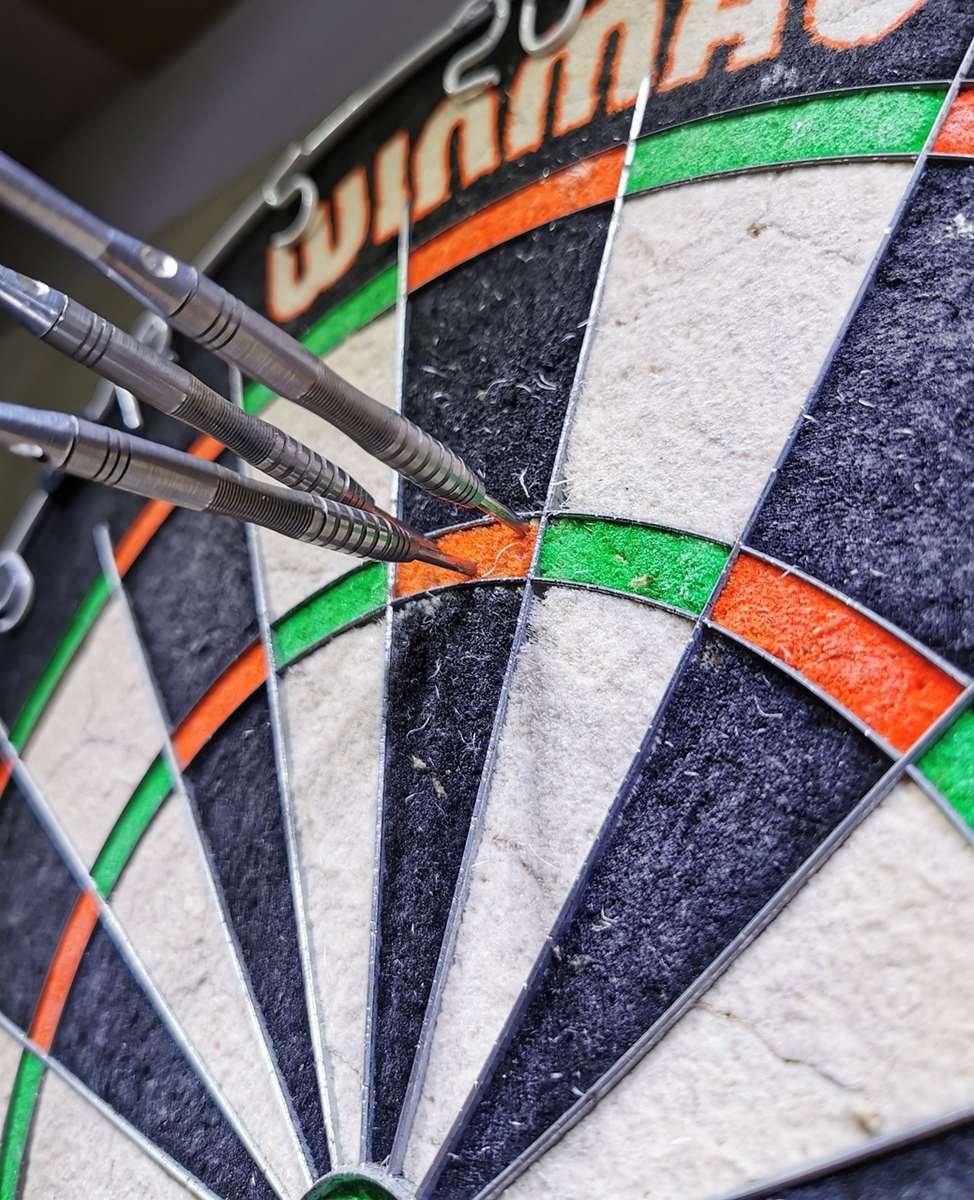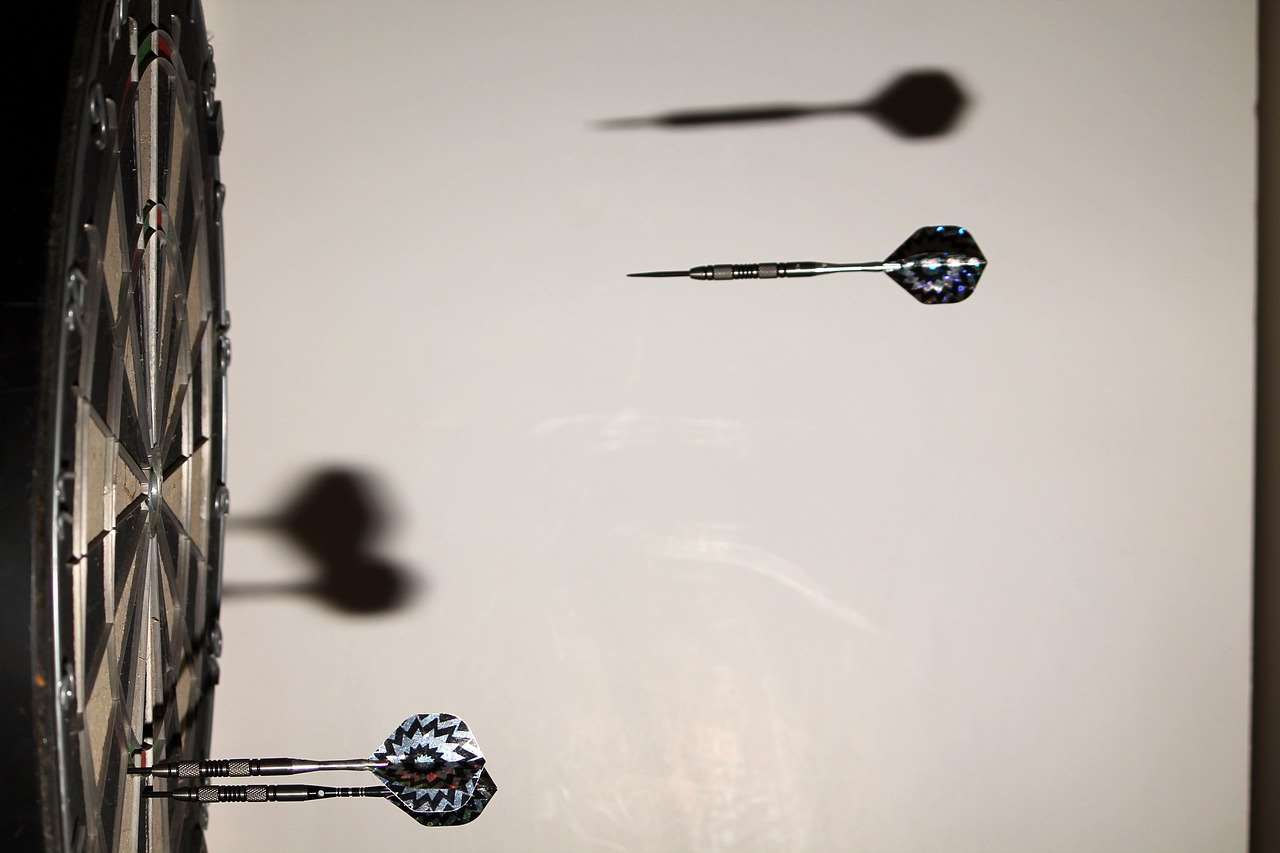The key to **measuring oche diagonally distance** correctly ensures fair play and prevents throwing line violations; it’s about using the hypotenuse of a right triangle to achieve the official distance of 9 feet 7 3/8 inches (2.93 meters) from the bullseye to the back of the oche. In this article, we’ll explore the precise method, necessary tools, and essential considerations for accurate dartboard setup and learn some Basic Darts Fundamentals for Beginners.
⚠️ Still Using Pen & Paper (or a Chalkboard)?! ⚠️
Step into the future! The Dart Counter App handles all the scoring, suggests checkouts, and tracks your stats automatically. It's easier than you think!
Try the Smart Dart Counter App FREE!Ready for an upgrade? Click above!
The Importance of Accurate Dartboard Setup and Measuring Oche Diagonally Distance
Proper dartboard setup is fundamental to enjoying a fair and competitive game of darts. While many focus on the height of the board, the distance from the oche (throwing line) is equally critical. The official distance is 7 feet 9 1/4 inches (2.37 meters) measured horizontally from the face of the board. However, **measuring oche diagonally distance** provides a more accurate and reliable method, accounting for variations in dartboard thickness and wall surfaces. Understanding **official dartboard dimensions** is paramount to the proper set up.

Incorrect distances can significantly impact a player’s throwing technique and scoring consistency. A throwing line that is too close gives an unfair advantage, while one that is too far can hinder performance. Precise measurements ensure that all players compete on a level playing field, allowing skill and strategy to determine the outcome. Furthermore, adhering to standardized distances is essential for sanctioned tournaments and leagues.
Benefits of Measuring Diagonally
- Accuracy: Diagonal measurement accounts for the dartboard’s thickness and the wall’s surface, providing a more precise distance.
- Consistency: It establishes a consistent throwing distance regardless of the dartboard’s mounting method.
- Fairness: Guarantees a level playing field for all players.
Understanding the Diagonal Measurement Method
Measuring oche diagonally distance involves using the Pythagorean theorem to calculate the hypotenuse of a right triangle. The vertical leg of the triangle is the height of the bullseye from the floor (5 feet 8 inches or 1.73 meters), and the horizontal leg is the standard throwing distance (7 feet 9 1/4 inches or 2.37 meters). The hypotenuse, which is the diagonal distance from the bullseye to the back of the oche, is approximately 9 feet 7 3/8 inches (2.93 meters).

Here’s the breakdown of the calculation:
- Square the height: (5 feet 8 inches)² = (1.73 meters)² ≈ 2.9929
- Square the horizontal distance: (7 feet 9 1/4 inches)² = (2.37 meters)² ≈ 5.6169
- Add the squares: 2.9929 + 5.6169 ≈ 8.6098
- Take the square root: √8.6098 ≈ 2.93 meters (9 feet 7 3/8 inches)
Tools and Materials Needed
To accurately measure the diagonal distance, you will need the following tools:
- Measuring Tape: A long measuring tape (at least 10 feet or 3 meters) is essential.
- Level: A level ensures the dartboard is mounted vertically.
- Pencil or Marker: For marking the oche position.
- Right Angle Square: Helps ensure the oche is perpendicular to the dartboard.
- Laser Distance Measurer (Optional): For even greater accuracy, consider using a laser distance measurer.
Step-by-Step Guide to Measuring Oche Diagonally Distance
Follow these steps to accurately measure the diagonal distance:
- Mount the Dartboard: Ensure the bullseye is 5 feet 8 inches (1.73 meters) from the floor. Use a level to verify the dartboard is vertical.
- Locate the Bullseye: Identify the center of the bullseye.
- Measure Diagonally: Using the measuring tape, extend it from the bullseye to the floor, aiming for a distance of 9 feet 7 3/8 inches (2.93 meters).
- Mark the Oche Position: At the point where the measuring tape reaches 9 feet 7 3/8 inches (2.93 meters), mark the floor. This is the back of the oche.
- Establish the Oche Line: Use a right angle square to ensure the oche line is perpendicular to the dartboard. Mark the line clearly.
- Verify the Horizontal Distance: As a final check, measure the horizontal distance from the face of the dartboard to the oche. It should be approximately 7 feet 9 1/4 inches (2.37 meters).

Common Mistakes to Avoid When Measuring
Even with the right tools and instructions, it’s easy to make mistakes. Here are some common pitfalls to avoid when **measuring oche diagonally distance**:
- Incorrect Bullseye Height: Double-check the bullseye height. A slight error here can significantly affect the diagonal distance.
- Not Accounting for Wall Surfaces: Ensure the measuring tape is flush against the wall and floor, especially if the wall has uneven surfaces.
- Using a Sagging Measuring Tape: A sagging tape measure will result in an inaccurate measurement. Keep the tape taut and straight.
- Measuring from the Dartboard Face: Always measure from the bullseye, not the face of the dartboard, for diagonal measurements.
The Oche: Beyond Distance
While **measuring oche diagonally distance** is crucial, the oche itself also requires attention. The oche should be a raised line or barrier that players must stand behind while throwing. Here are some considerations:
- Material: The oche can be made of wood, metal, or even a simple strip of tape.
- Height: A slight elevation (e.g., a piece of wood) can help players maintain their balance and prevent foot faults.
- Visibility: Ensure the oche is clearly visible, especially in low-light conditions.
Advanced Tips for Accurate Dartboard Setup
For those seeking the utmost precision, consider these advanced tips:
- Use a Laser Level: A laser level provides a highly accurate reference for both the bullseye height and the vertical alignment of the dartboard.
- Double-Check Measurements: After completing the setup, have another person verify the measurements.
- Account for Dartboard Rotation: Over time, dartboards can rotate slightly. Periodically check and readjust the measurements as needed.

By understanding these details, you can ensure that you are set up to play a proper game. It is important to know what Fun dart game variations with modified rules can be played after the initial setup.
Adapting the Oche for Different Players and Spaces
Sometimes, standard distances aren’t feasible due to space constraints or player abilities. Here are some ways to adapt the oche while maintaining fairness:
- Shorter Distances for Beginners: For children or beginners, consider shortening the throwing distance temporarily.
- Adjustable Oches: Install an adjustable oche that can be easily moved to accommodate different players.
- Marked Distances: Clearly mark different throwing distances for various skill levels.
Be sure to modify rules for mixed-level dart players, ensuring everyone has fun. You can find more on this topic here.
Maintaining Your Dartboard Setup
Once your dartboard is set up correctly, it’s essential to maintain it. Regular maintenance ensures the accuracy of the setup and prolongs the life of your dartboard:
- Rotate the Dartboard: Regularly rotate the dartboard to distribute wear evenly.
- Check Measurements Periodically: Re-check the bullseye height and diagonal distance every few months.
- Tighten Fasteners: Ensure all mounting hardware is secure.

Conclusion
Accurate dartboard setup is critical for fair play and consistent performance. **Measuring oche diagonally distance** offers a precise method for establishing the correct throwing distance, ensuring that all players compete on a level playing field. By following the steps outlined in this article and using the recommended tools, you can create a professional and enjoyable dart-playing experience. Remember to adapt the oche for different players and spaces and maintain your setup regularly to prolong its accuracy and lifespan. Now that you understand the importance of correct distance and measurement, grab your darts and enjoy the game! Be sure to check out alternative darts rules for home play for more fun.
Hi, I’m Dieter, and I created Dartcounter (Dartcounterapp.com). My motivation wasn’t being a darts expert – quite the opposite! When I first started playing, I loved the game but found keeping accurate scores and tracking stats difficult and distracting.
I figured I couldn’t be the only one struggling with this. So, I decided to build a solution: an easy-to-use application that everyone, no matter their experience level, could use to manage scoring effortlessly.
My goal for Dartcounter was simple: let the app handle the numbers – the scoring, the averages, the stats, even checkout suggestions – so players could focus purely on their throw and enjoying the game. It began as a way to solve my own beginner’s problem, and I’m thrilled it has grown into a helpful tool for the wider darts community.